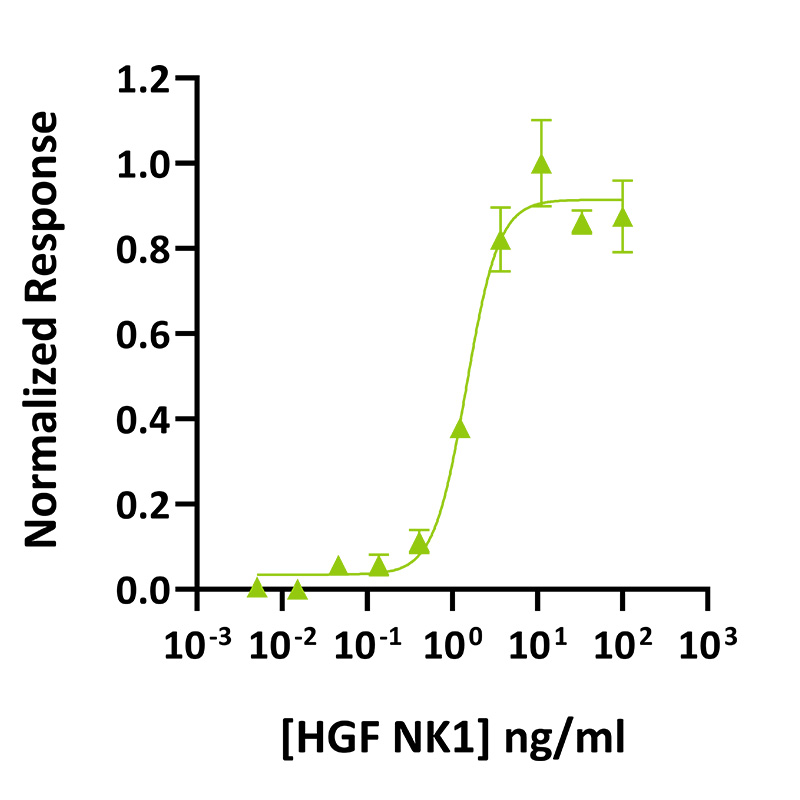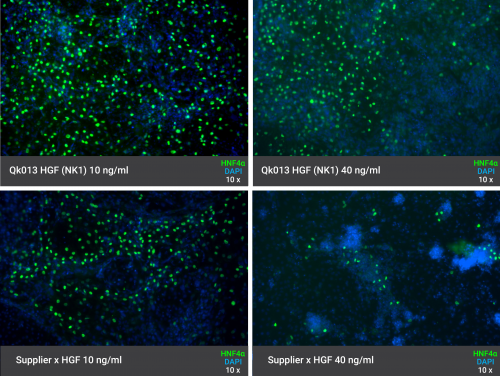 Recombinant human HGF NK1 protein (Qk013)
Recombinant human HGF NK1 protein (Qk013)Recombinant human HGF NK1 protein (Qk013)
Price range: £140.00 through £1,400.00
Hepatocyte growth factor (HGF) is a multi-functional cytokine that promotes the growth and proliferation of various cell types including mesenchymal, endothelial, and epithelial cells. It is involved in embryonic development, cell motility, survival, angiogenesis, and tissue regeneration. In cell culture, HGF is used to promote the differentiation of mesenchymal cells towards hepatocytes, osteocytes, and endothelial cells.
Recombinant human HGF NK1 protein is a potent naturally occurring isoform of HGF. This protein is animal origin-free, carrier protein-free, and tag-free to ensure its purity with exceptional lot-to-lot consistency with a molecular weight of 20 kDa. It promotes efficient differentiation of human induced pluripotent stem cells to hepatocyte-like cells at just 10 ng/ml with highly homogeneous expression of the hepatic marker, HNF4α.
In stock
Orders are typically shipped same or next day (except Friday).
Easy world-wide ordering, direct or through our distributors.
Price range: £140.00 through £1,400.00
Buy online with secure credit card or purchase order. For any questions, please email orders@qkine.com
Summary:
- High purity human HGF NK1 protein (Uniprot: P14210)
- 20 kDa
>98%, by SDS-PAGE quantitative densitometry
Expressed in E. coli
Animal origin-free (AOF) and carrier protein-free
Manufactured in our Cambridge, UK laboratories
Lyophilized from acetonitrile, TFA
- Resuspend in 10 mM HCl (Reconstitution solution A) at >50 µg/ml, add carrier protein if desired, prepare single-use aliquots and store frozen at -20 °C (short-term) or -80 °C (long-term)
Featured applications:
Differentiation of iPSCs to hepatocyte-like cells

HGF NK1 activity was determined using a quantitative Promega serum response element luciferase reporter assay (*) in transfected HEK293T cells. Cells were treated in triplicate with a serial dilution of HGF NK1 for 6 hours. Firefly luciferase activity was measured and normalized to the control Renilla luciferase activity. EC50 = 1.5 ng/ml. Data from Qk013 lot #010. *Promega pGL4.33[luc2P/SRE/Hygro] #E1340
Recombinant HGF NK1 migrates as a major band at approximately 21 kDa in reduced (R) and at approximately 18 kDa in non-reduced (NR) conditions. No contaminating protein bands are present. The purified recombinant protein (3 µg) was resolved using 15% w/v SDS-PAGE in reduced (+β-mercaptoethanol, R) and non-reduced (NR) conditions and stained with Coomassie Brilliant Blue R250. Data from Qk013 lot #104451.

Further quality assays
Mass spectrometry: single species with expected mass
Recovery from stock vial: >95%
Endotoxin: <0.005 EU/μg protein (below level of detection)
We are a company founded and run by scientists to provide a service and support innovation in stem cell biology and regenerative medicine. All our products are exceptionally high purity, with complete characterisation and bioactivity analysis on every lot.
Protein background
Hepatocyte growth factor (HGF), or scatter factor (SF), is a multifunctional cytokine that acts as a mitogen and promotes the growth and proliferation of various cell types, including mesenchymal, endothelial, and epithelial cells [1, 2]. During embryonic development, it stimulates the development of various organs, such as the liver, kidneys, and lungs [2–4]. It plays a crucial role in adulthood by regulating cell motility, survival, angiogenesis, and tissue regeneration, particularly in liver regeneration [2]. It is also involved in tissue homeostasis and is released triggered by factors such as injury, stress, and inflammation. HGF has been implicated in promoting osteogenic, chondrogenic, and adipogenic differentiation of mesenchymal cells [3, 4].
In cell culture, HGF is used for various applications. HGF modulates cell fate and promotes the differentiation of specific lineages in particular mesenchymal cells [5, 6]. HGF is essential for the growth, survival, and maintenance of hepatocytes and endothelial cells [7, 8]. Finally, HGF is used to study cell cycle, division, motility, invasion, and wound healing [7].
HGF binds and activates the receptor tyrosine kinase, c-Met; through this receptor, HGF activates PI3K/AKT, FAK, JNK, and ERK1/2 signaling [1, 9]. HGF is secreted as a single inactive polypeptide and is cleaved by serine proteases into a 62-kDa heavy-chain and 32-36 kDa light-chain [1]. A disulfide bond between the heavy and light chains produces the active αβ heterodimeric molecule [1, 10]. Alternative splicing of HGF produces multiple transcript variants encoding different isoforms. The NK1 isoform is the most minor naturally occurring splice variant, it comprises the HGF N-terminal hairpin loop domain (involved in the c-Met receptor binding) and the first kringle domain [11].
Due to its involvement in cell growth and tissue repair, HGF has attracted attention in regenerative medicine and potential therapeutic interventions. Additionally, the dysregulation of HGF and its receptor c-Met has been implicated in various diseases, including cancer, where aberrant signaling contributes to tumor growth, invasion, and metastasis [1, 2, 12, 13].
Customer & collaborator data
High purity, animal and carrier protein-free HGF protein for chemically-defined media and more reproducible scale-up
Recombinant human HGF NK1 protein promotes efficient differentiation of human iPSCs to hepatocyte-like cells. HGF NK1 supports human iPSC differentiation to hepatocyte-like cells. Defined media was supplemented with HGF NK1 (Qk013) during day 8-18 of the hepatocyte differentiation protocol (adapted from Heck W, et al. 2015). Cells attain characteristic hexagonal epithelial morphology. Expression of hepatic marker, HNF4α, and polarisation marker, E-Cadherin (ECAD), was detected using immunofluorescence.
Highly homogeneous expression of HNF4α in hepatocyte-like cells differentiated from iPSCs using Qk013 HGF NK1. Growth in media supplemented with HGF NK1 (Qk013) leads to highly homogeneous expression of hepatic marker, HNF4α. iPSCs were treated with hepatocyte differentiation media supplemented with HGF NK1 or full-length, mammalian cell-derived HGF from another commercial source.
All experiments have been conducted by the specialist stem cell biotechnology company, Stemnovate Limited, in Cambridge, UK.

Additional resources
- Technote | HGF NK1 (Qk013) bioactivity
- Technote | HGF NK1 (Qk013) stability
- Stability of Qkine recombinant growth factors and cytokines in conditioned media (PDF)
- Poster: Pluripotent stem-cell derived organoids
- Poster: Adult stem-cell derived organoids
- Brochure: Growth factors for neural and glial cell differentiation
- Brochure: Growth factors for enhanced organoid culture protocols
Publications using Recombinant human HGF NK1 protein (Qk013)
-
mTOR activity paces human blastocyst stage developmental progression
Iyer DP, Khoei HH, van der Weijden VA et al.
DOI: doi: 10.1016/j.cell.2024.08.048
FAQ
HGF stands for hepatocyte growth factor, a multifunctional cytokine.
HGF is a protein that is found in various tissues and organs throughout the body such as the liver, kidneys, lungs, pancreas, blood vessels, muscles, central nervous system, and placenta.
HGF is produced by various cell types including mesenchymal cells, hepatocytes, smooth muscle cells, epithelial cells, firbroblasts, and other stromal cells.
The alternative name of HGF is scatter factor (SF).
Yes, it is a multifunctional cytokine.
The HGF gene, also know as SF, HGFB, HPTA, F-TCF or DFNB39 provides instructions for synthesizing the protein HGF. Alternative splicing results in multiple transcript variants, at least one of which encodes a preproprotein that is proteolytically processed to generate alpha and beta chains, which form the mature heterodimer.
HGF binds to Hepatocyte Growth Factor Receptor (HGFR), also known as c-Met.
The Hepatocyte Growth Factor Receptor (HGFR), also known as c-Met, is a receptor tyrosine kinase that plays a crucial role in mediating the biological effects of Hepatocyte Growth Factor (HGF). The c-Met receptor is expressed on the surface of various cell types, and its activation initiates a cascade of intracellular pathways involved in cell proliferation, migration, angiogenesis, regeneration, and embryonic development.
HGF pathway, also known as the HGF/c-Met pathway, involves a series of molecular events triggered by the binding of HGF to its receptor, c-Met. It activates downstream signalling pathways such as the RAS-RAF-MAPK, PI3K-AKT, STAT3, and Wnt/β-catenin Pathways.
In cell culture, HGF is used for various applications such as the differentiation of specific lineages in particular mesenchymal cells and the growth, survival, and maintenance of hepatocytes and endothelial cells. HGF is also used in assays to study cell cycle, division, motility, invasion, and wound healing.
Yes, HGF regulates the differentiation of mesenchymal cells into hepatocytes, osteocytes and endothelial cells.
Our products are for research use only and not for diagnostic or therapeutic use. Products are not for resale.
For use in manufacturing of cellular or gene therapy products. Not intended for in vivo applications.

Receive an Amazon gift voucher when you leave us a review.
£25, $30 or €30 for reviews with an image and £10, $15 or €15 for reviews without an image


